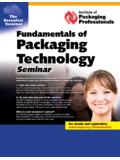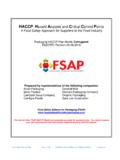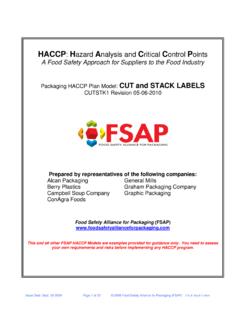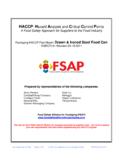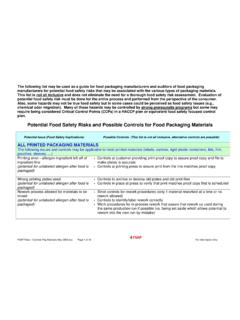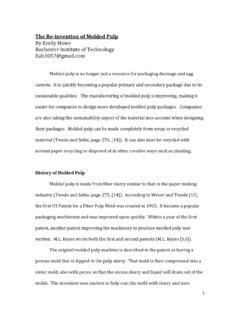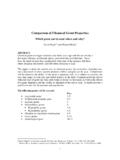Transcription of Flexible Packaging: Innovations and Developments
1 Flexible packaging : Innovations and Developments Erin Hoppe University of Wisconsin Stout 2009 Italian packaging Technology Award Abstract Since the creation of Flexible films, the packaging industry has been propelled to astonishing heights. Through the development and utilization of these films, manufacturing practices, and continual Innovations , the field of packaging has been able to grow and evolve to adapt to the needs of products around the globe. Due to Flexible film s many desirable characteristics, the implementation of various manufacturing methods and polymer additions provides the means to increase appeal to a broad spectrum of products. Flexible films have an illustrated history in packaging , and there are continually enhancements and improvements, as well as new products being marketed.
2 In this paper, the history, manufacture, and recent Innovations of Flexible films will be addressed, as well as the importance and impact Flexible films has had on the packaging industry as a whole, and what the packaging future holds for Flexible films. INTRODUCTION With the United States commanding $135 billion in the worldwide packaging industry ( Flexible packaging Association), the Flexible packaging industry is the second largest sector of the business with Flexible packaging offering consumers extensive desirable characteristics, it is easy to see why. From ease of handling and storage, overall cost savings, and convenience, Flexible packaging has cemented itself in the packaging world, and has undoubtedly been a key contributor to packaging s continued success.
3 The popularity of utilizing Flexible packaging and films for packaging is largely based on the numerous technical Developments that have been made in the field. Flexible packaging and film possess good barrier properties on their own, but with the aid of coatings, film types, and manufacturing methods, the positive attributes skyrocket. HISTORY While there are many polymers utilized in the Flexible packaging industry, the most common are polypropylene (PP), polyethylene (PE), polyvinyl chloride (PVC), polyethylene terephthalate (PET), and biaxially oriented polypropylene (BOPP) (Anyadike). Polyvinyl Chloride (PVC) Though initially created in 1872, PVC was not patented until 1913 by Friedrich Klatte. When PVC was plasticized in 1926, it was not long after that it began to widely gain popularity in packaging .
4 With good cling and barrier properties , along with good heat seal properties ; PVC is often used in the manufacture of films for meats and produce as well as being a popular choice for blisterpacks. In recent years, PVC has received negative attention from environmentalists, and very little growth is expected in the future (Anyadike). Polyethylene (PE) In 1933, PE was discovered by Fawcett and Gibson at the British company Imperial Chemical Industries. After a reaction occurred between ethylene and benzaldehyde, the substance that was left behind ultimately became polyethylene (The History of Plastic). Polyethylene later progressed to become three variations of itself high density polyethylene (HDPE), low density polyethylene (LDPE), and linear low density polyethylene (LLDPE).
5 HDPE, LDPE, and LLDPE are used in Flexible packaging applications due to their flexibility, good low temperature performance, durability, high moisture barrier, and ability to seal to itself without any coating. PE is by far the most used plastic film material that is used in Flexible packaging , and its growth (in Europe) is around a year (Anyadike). Polyethylene Terephthalate (PET) With 1941 came PET. At the Calico Printer s Association in Manchester, England, Rex Whinfield and James Dickson furthered research that had previously been done by Wallace Carothers (Bellis). PET possesses excellent high temperature properties , high strength and clarity, and has high oxygen and carbon dioxide barrier properties . Often used for medical application pouches, boil in bag applications, meat, snack, and baked goods, PET is an important player in the field of Flexible packaging .
6 Polypropylene (PP) The 1950 s brought forth the introduction of PP. Paul Hogan and Robert Banks, both of whom were working for Phillips Petroleum, were ultimately credited with the invention of PP (A Plastics Explosion Polyethylene, Polypropylene, and Others). After finding that modification of their original catalyst of nickel oxide to include chromium oxide, the chromium produced a material polypropylene. PP is commonly used in moisture proof wrapping, fat resistant films, and in the manufacture of medical packaging due to its low moisture absorption, high chemical resistance, and low permeability to moisture. MANUFACTURING PROCESSES Just as there are many different types of film materials, there are various forms of manufacturing processes and technologies. Each having its own pros and cons, it is important to distinguish between them, and know the impact that they will ultimately have on the film.
7 With every combination of resin type, and processing method, a unique set of characteristics will be produced. Blown Film Blown film manufacturing involves using a jet of air to blow the (melted) plastic polymer through a circular blown film die. The melted plastic then forms a continuous tube, which is inflated, flattened by rollers, and cut to length resulting in double thickness film. Blown film is one of two main processes that are used in the manufacture of film products since it is efficient (little polymer is needed to produce a lot of film) and used in a wide variety of applications. Figure 1. Blown Film Manufacturing Diagram (PlasticsDome) Cast Film Cast film is manufactured by extruding the melted polymer through a flat die or slot forming a thin sheet or film.
8 After extrusion, it is attached to the surface of a chilled (rotating) roller so that it is cooled extremely fast. It is the surface of the rotating roller that gives cast film its characteristic smooth and clear appearance. While cast film can be produced at much higher line speeds, there is higher waste along with little orientation in the cross direction (Anyadike). Coextrusion Barrier packaging would not be what it is today had it not been for the discovery of the multilayer structure (MLS). Prior to the development of coextrusion technology, multilayer films were produced by laminating thin plastic layers together. While this process of lamination worked, it was found to be slow and not very efficient. Coextrusion involves combining two or more layers of melted plastic into a single extruded web (Anyadike).
9 Figure 2. Coextrusion Manufacturing Diagram (PlasticsDome) Coextrusion provides the unique opportunity to combine desired properties of various polymers to ultimately form one material that would otherwise be impossible to achieve by using a single polymer alone. Barrier packaging introduced additional benefits to the Flexible packaging industry and since its premier in the packaging world; MLSs have been the catalyst for numerous Innovations to come. Innovations AND ADVANCEMENTS Along with the continual development and demand for new, different, and desirable characteristics and properties of film types has come the creation of new polymers to fill these needs. From adding additional sought after characteristics that some products demand, creating environmentally friendly alternatives, or simply producing a film for consumer pleasure, the advancements that have been, and continue to be made in the field are numerous.
10 Metalized Films One of the more popular Innovations that has taken place in the recent past is the introduction of metalized films. With the application of a layer of aluminum to a polymer s surface, the finished product proves to be more resistant to both water and oxygen transmission as well as providing a metallic and glossy appearance much like that of aluminum foil. The ability to provide some of the key properties possessed by aluminum foil, for a considerably lower cost and tare weight makes metalized films a popular choice in the food and confectionary fields. Modified Atmosphere packaging Modified atmosphere packaging (MAP) can be credited with providing the food packaging industry with increased shelf life of minimally processed foods. By modifying the internal environment of the package, the natural deterioration of the product is slowed down preserving its fresh state for a longer period of time.
